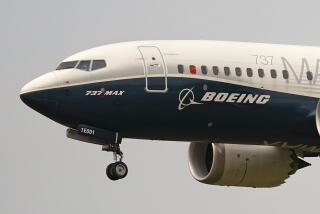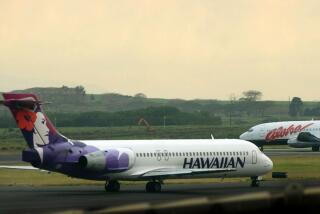Boeing Aims to Fill Skies With Surfers
Boeing Co. said Wednesday that it is forming a joint venture with three of the nation’s largest airlines to provide in-flight e-mail and Internet access to passengers, kicking off one of the most ambitious efforts yet to wire the skies.
AMR Corp.’s American Airlines, Delta Airlines Inc. and UAL Corp.’s United Airlines, which combined operate nearly 2,000 airplanes, have signed a letter of intent with Boeing to deploy a satellite-based system that would provide high-speed Internet connections, the companies said.
The proposed pact is a coup for Boeing and its Irvine-based unit that has struggled to sign up airline customers amid questions over who would pay for installing the equipment and how the revenue from the service would be divided. About 300 engineers at the unit known as Connexion by Boeing are developing the system.
Getting the top three domestic airlines to sign up as partners appears to have resolved some of the issues, although negotiations are still continuing over the details, the companies said. Boeing said it and the airlines hope to sign a definitive agreement by the end of the year that would also include marketing the service to other airlines.
Boeing said it would charge passengers about $20 an hour. Passengers would be able to surf the Web, access e-mail or get live television after hooking up their laptops to the airplane seat.
Boeing shares fell 22 cents on Wednesday to $65.49 on the New York Stock Exchange.
Boeing has said the business could generate as much as $5 billion in annual revenue once the service gains widespread acceptance.
“That’s a pretty nice start,” said Paul H. Nisbet, an aviation analyst with JSA Research Inc. “They seemed to have solved the problem of who owns what.”
The deal also could help the world’s largest aircraft maker leap past a competing system that is undergoing tests by several international carriers, including Singapore Airlines and Britain’s Virgin Atlantic Airways. Since April, Singapore Airlines has been providing limited e-mail and Web access developed by Tenzing Communications Inc., a tiny Seattle start-up, to its first-class and business-section customers on some international flights.
In addition, the move is expected to put added pressure on Boeing’s chief European rival Airbus Industrie, the world’s second-largest commercial airplane maker. Airbus is reportedly set to announce it is taking a 30% stake in Tenzing, extending its competition with Boeing to in-flight Internet.
Boeing and the three airlines declined to say exactly how their venture would be structured, but the airlines would have a minority stake, with Boeing developing and managing the service. They also declined to disclose the financial terms of the deal.
Once the agreement is signed, Boeing said each airline would initially equip 10 airplanes with the system, beginning in the second half of 2002. Each system is expected to cost about $1.5 million. Boeing said initially the system probably would be on longer-range airplanes making transcontinental trips.
Eventually, each airline would install the system on about 500 of Boeing’s airplanes for a combined total of 1,500 planes, representing more than half of all U.S. passenger traffic.
“Each of the airlines and Boeing bring together a critical mass to help ensure the success of this service,” said Scott Carson, president of Connexion by Boeing, which was created last year to develop the system.
Boeing’s system would differ from Tenzing’s service by providing a two-way high-speed connection via satellites. Tenzing’s system is significantly cheaper to install because it mainly uses already available equipment and software and is similar to ground-based telephone connections, which runs at 56 kilobits per second.
Boeing’s system would provide real-time connections with speeds that would be comparable to that available in office networks. The system would be able to receive information at 5 megabits per second while data would be sent from the plane at 1.5 megabits per second, or about as fast as a T1 line.
Connection speeds will vary, however, depending on the number of passengers using the service, but each flier would be guaranteed a speed of at least 56 kilobits per second, Carson said.
Boeing said it can provide such connection speeds because it uses a phased array antenna that engineers developed for the Defense Department in the 1980s. The surfboard-like antenna attached to the roof of the airplane stays locked on a satellite even as the plane is cruising at 500 mph, providing constant, real-time connections.
More to Read
Inside the business of entertainment
The Wide Shot brings you news, analysis and insights on everything from streaming wars to production — and what it all means for the future.
You may occasionally receive promotional content from the Los Angeles Times.










